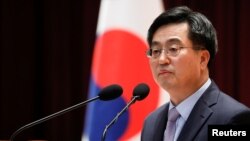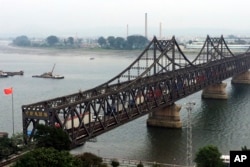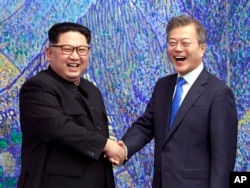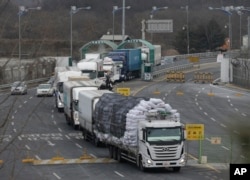South Korea is looking into developing and financing economic projects with North Korea that could take effect if a nuclear deal is reached with the United States.
South Korean Finance Minister Kim Dong-yeon said on Wednesday the government was “internally carrying out preparations” to organize, finance and implement possible inter-Korea projects. But he also emphasized that Seoul would first seek support from the international community for any North Korean development projects, and would only proceed if the U.S. -North Korea summit, expected to be held in late May or June, produces a joint denuclearization agreement.
North Korea is under tough sanctions imposed by the U.N. Security Council for its nuclear weapons and missiles tests, including accelerated efforts in the last two years to develop a long-range nuclear missile that could potentially target the U.S. mainland. The international sanctions ban an estimated 90 percent of the country’s external trade.
Seeking sanctions relief is considered a key motivating factor in North Korean leader Kim Jong Un’s diplomatic pivot this year to suspend further provocative missile and nuclear tests, and to engage in talks to dismantle his nuclear arsenal.
But easing sanctions would make it more difficult to enforce the North’s denuclearization promises.
“Once the sanctions are lifted, North Korea will gain autonomy over its trade, and considering its low labor costs and skilled workforce, I think the North Korean economy would gain power again,” said Shin Beom-chul, the director of Center for Security and Unification at the Asan Institute for Policy Studies in Seoul.
U.S. President Donald Trump has insisted he will keep sanctions in place until North Korea completely dismantles its nuclear program.
Infrastructure projects
South Korea, however, is considering a range of economic incentives to encourage Kim to follow through on a nuclear deal with Trump. But these investments are prohibited by the U.N. sanctions and would require a Security Council exemption to proceed.
At the recent inter-Korean summit, Kim and South Korean President Moon Jae-in agreed to increase economic cooperation, in addition to supporting the complete denuclearization of the Korean Peninsula.
Developing modern railways that would connect South and North Korea to Russia and China were specifically mentioned in their joint statement. Other possible projects include improving seaports, as well as building roads and electrical power plants in the impoverished and underdeveloped North.
The cost of these infrastructure projects could cost more than $65 billion, and would require extensive financing, as South Korea currently has only $1 billion in its Inter-Korean Cooperation Fund that was established for this purpose.
If North Korea does give up its nuclear weapons, there will likely be economic aid provided by strategic regional powers, including the U.S., China, Japan and Russia. But South Korea is taking a proactive role to be a major investor in developing the North’s mineral trade and other markets.
“It is expected that South Korea will carry most of the costs. In fact there are many economic resources that are strategically valuable in developing North Korea,” said Joung Eun-lee, a research fellow at the Korea Institute for National Unification.
Peacetime economy
Funding infrastructure projects could also help transition the North to a peacetime economy, even while the trade sanctions remain in place.
The two Koreas have agreed to pursue a peace treaty to replace the armistice put in place at the end of the Korean War in 1953. If implemented, North Korea would likely be expected to significantly reduce its conventional forces that currently include over one million soldiers.
International funding could also be used to provide jobs for former soldiers to work on building roads, bridges and other needed development projects.
“It is not so much the relaxation of the trade sanctions as it is subsidized infrastructure development. That is what North Korea needs upfront,” said Bruce Bennett, a North Korea analyst at the Rand Corporation research organization.
South Korea had invested billions of dollars into North Korean development projects in the past, like the Kaesong Industrial Complex that employed over 5,000 North Korean workers before it was shut down in 2016 following a nuclear test, and the Kumgang Mountain tourism program that ended when a South Korean visitor was shot by a North Korean soldier in 2008.










